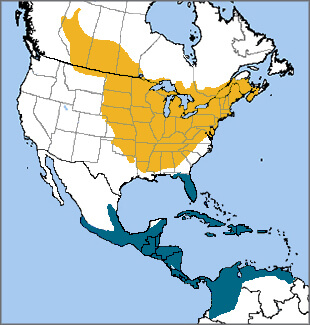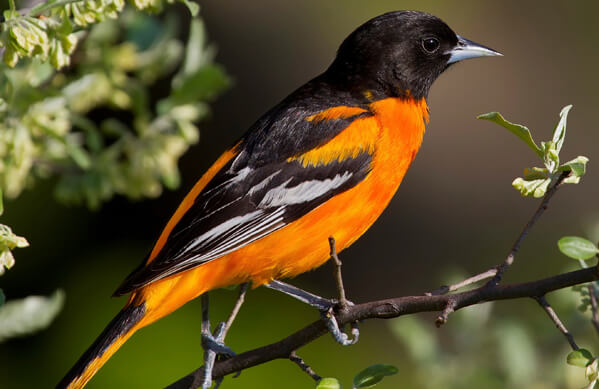 The eye-catching orange and black plumage of the Baltimore Oriole echoes the colors on the coat of arms of England's Baltimore family, some of the first administrators of the state of Maryland. The species is Maryland's state bird and the namesake of its pro baseball team.
The eye-catching orange and black plumage of the Baltimore Oriole echoes the colors on the coat of arms of England's Baltimore family, some of the first administrators of the state of Maryland. The species is Maryland's state bird and the namesake of its pro baseball team.
The Baltimore Oriole (and all American orioles) are actually members of the blackbird family, so are related to Tricolored Blackbird. Habitat loss on breeding and wintering grounds, pesticide use, and collisions with glass and towers are the chief threats to this species.
Oriole of Distinction
The Baltimore Oriole and more western-ranging Bullock's Oriole were once considered the same species, known as the Northern Oriole, since the two hybridize where their ranges meet in the Midwest. Subsequent DNA studies showed that they are two separate species (not even closely related), so the American Ornithologists' Union split them in 1995.
Insect Control, Oriole-style
During the breeding season, Baltimore Orioles voraciously feed on caterpillars—even hairy ones that many other bird species avoid—insects, and spiders. They forage while moving through the treetops, gleaning from leaves and branches, and even picking insects from spider webs. By feeding on large quantities of larvae and insects, the Baltimore Oriole protects trees from extensive damage, providing a valuable ecological service.
Baltimore Orioles are fond of fruit; interestingly, they seem prefer dark-colored fruit such as mulberries and black cherries. They readily visit backyard feeders for oranges, jam, and nectar.
Although Baltimore Orioles primarily eat insects in the summer, they switch to more nectar and fruit in the fall and winter.
Sign up for ABC's eNews to learn how you can help protect birds
Building a Better Nest
Each spring, newly arriving male orioles sing constantly from treetop perches to attract a mate. Their distinctive song, a rich, variable series of whistles, is often the first clue to their presence. Female Baltimore Orioles also sing, often while foraging, but have a simpler song.
Once mated, the female selects a nest site in the male's territory, and begins to build her pendulous, purse-like nest at the end of a branch. Nest construction usually takes about a week, and proceeds in three stages. First the female builds an outer support structure of plant material, animal hair (especially horsehair), or human-made fibers such as string, then weaves flexible fibers, such as grapevine or Spanish moss, into an inner bowl. To finish, the female oriole lines the nest with downy materials including milkweed seed plumes and feathers.
Male Baltimore Orioles will bring some material to the nest site, but the female does all the nest construction. Baltimore Orioles do not reuse their nests from year to year, but females will sometimes pull apart a previous year's nest for materials.
Once she lays her clutch of 3-7 eggs, the female oriole does all the incubation. Both parents feed the nestlings, which fledge in a few weeks. Baltimore Orioles only raise one clutch per season. They begin to migrate quite early, often leaving their territories as early as July to head south.

Female Baltimore Oriole weaving her nest. Photo by Paul Reeves Photography, Shutterstock
Coffee for Orioles
Although Baltimore Oriole populations are widespread and considered stable, they have shown some declines, particularly as large shade trees such as American Elm have become scarce due to introduced disease.
ABC has successfully advocated for the cancellation of pesticides shown to kill the Baltimore Oriole and other birds, and continues to promote bird-friendly building practices to reduce glass collisions.
Baltimore Orioles often winter in the open forest habitat provided by shade-grown coffee and cacao plantations, along with species such as Wood Thrush, Ruby-throated Hummingbird, and Scarlet Tanager. As part of its full annual life-cycle strategy, ABC cooperates with local landowners and nonprofits in Central and South America to protect this important wintering habitat.
Donate to support ABC's conservation mission!



















































